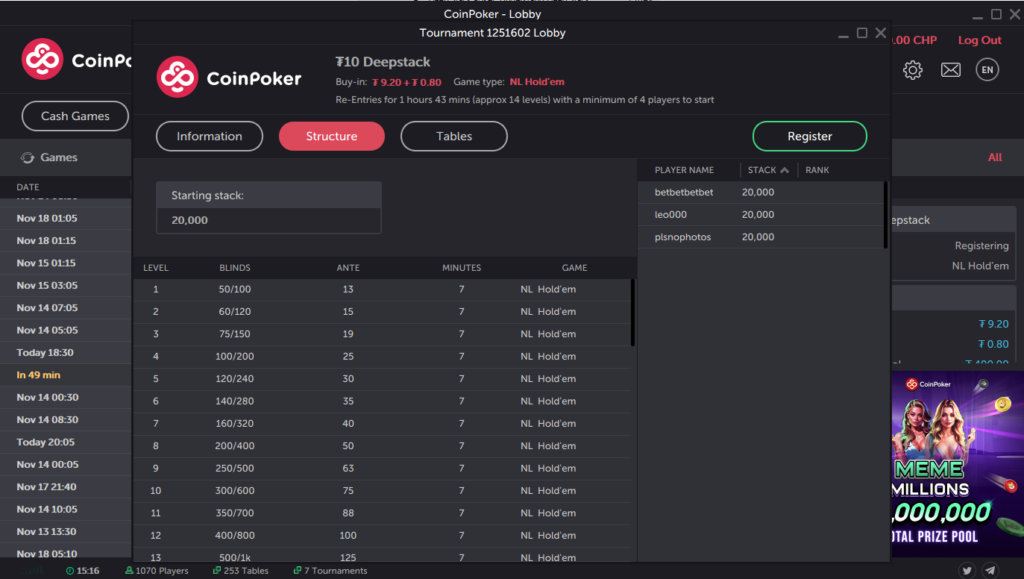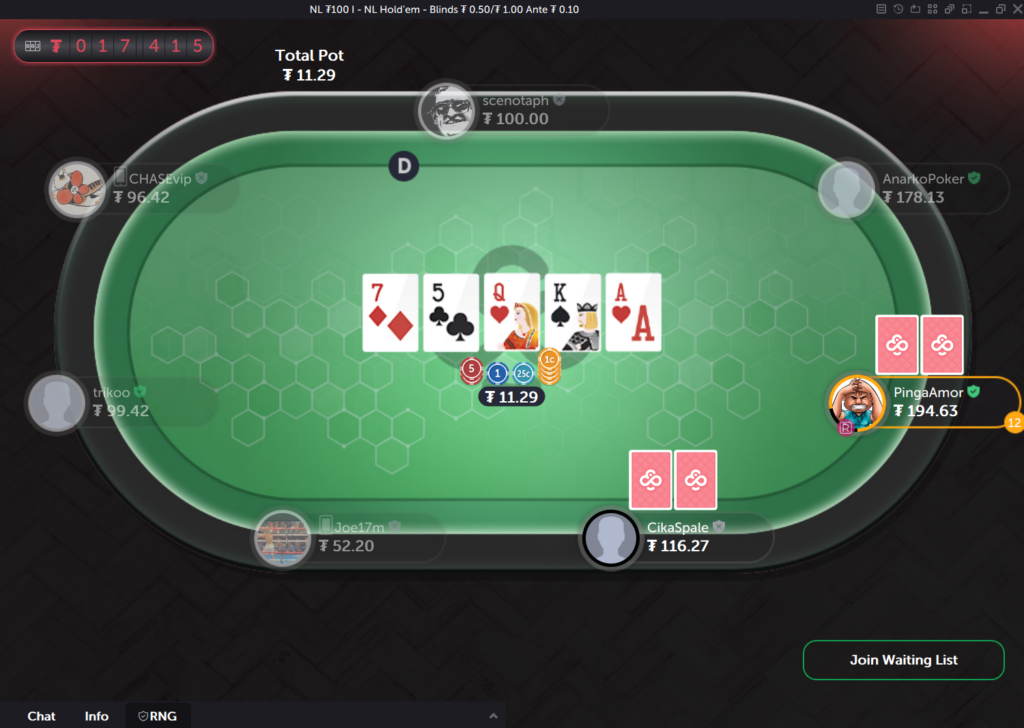Last Updated: 15 August 2025
Deep Stack Poker: Understand Deep Stack MTTs and Cash Games
Nothing beats playing deep stack poker, but without strategy, you’ll end up short-stacked. We’ll explain it all, and explain how to play deep-stacked.
StrategyWelcome to our guide on deep stack poker! Here, we’ll take an in-depth look at how deep stack poker differs from other styles, learn essential strategies for success, and find tips to dominate deep stack tournaments or cash games.
Whether you’re playing from your computer or on the go with your mobile device, our guide will equip you with the skills needed for this popular poker format.
What is Deep Stack Poker?
Deep stack poker refers to games where players start with a significantly larger number of big blinds than in standard poker formats.
But what does deep stack mean in poker? In deep stack play, the increased number of chips per player allows for more creative and calculated decisions over each hand, making it a highly strategic game format.
For comparison, here’s how starting stack sizes vary:
| Stack Type | Big Blinds (BB) | Typical Play Style |
| Short Stack | < 40 BB | Play aggressively and focus on maximizing value quickly, as fewer chips limit post-flop maneuvering. |
| Regular Stack | 40-150 BB | Balance aggression with caution, taking time to make selective plays and leverage both pre-flop and post-flop strategies. |
| Deep Stack | 150+ BB | Emphasize patience and creativity, allowing for more complex decisions and effective bluffing strategies as the hands progress. |
To know if you’re “deep stacked,” consider if you’ll have enough chips to withstand multiple large bets without going all-in. In contrast to short or regular stacks, deep stacks allow for a wider range of strategies and more intricate post-flop play. That is generally rewarding players who can adapt to longer, more strategic games.
Deep Stack Tournaments vs Deep Stack in Cash Games
When it comes to deep stack poker, the experience varies significantly between multi-table tournaments (MTTs) and cash games.
So, what is a deep stack poker tournament? In this type of tournament, players start with large stacks relative to the blinds, allowing for extensive play and more strategic depth. Like normal tournaments, blinds gradually increase, adding pressure to build and maintain a healthy stack, especially in the later stages. The major difference is that pressure ramps up a lot slower in deep stack MTTs.
For example, take a look at the blind structure of this Deepstack tournament on CoinPoker. Players start the tournament with 200 big blinds (200bb), while normal tournaments start with 100 big blinds or less.

In cash games, a deep stack player benefits from relatively consistent stack size and fixed blinds, allowing for flexible betting strategies and more calculated plays. On top of that, having a deeper stack means players can go for all the chips when they hold premium combinations.
Unlike tournaments, cash game players can reload at any time if their stack dips, but in a cash game, you won’t be able to reload back to deep stack size. Any time there’s a rebuy, the limit is set at a table maximum, which often won’t be enough to be considered a deep stack.

Each format has its unique challenges: tournaments offer evolving dynamics, while cash games reward consistent, calculated play. Mobile apps have made it easier than ever to join deep stack tournaments from anywhere, allowing for a more flexible playing experience.
How to Play Deep Stack Poker
You just entered your first deep stack tournament or built a deep stack in a cash game, and the possibilities feel endless. With a larger stack, you’re no longer forced into playing tight or overly cautious. There’s room for creativity and strategy in every hand! But deep stack play comes with its own set of challenges and requires a few key adjustments to play optimally.
Next, we’ll break down essential strategies, adjustments, and tips that will help you dominate deep stack games, one hand at a time.
Deep Stack Poker Strategy
In deep stack poker, understanding stack sizes and staying flexible with preflop and postflop strategies is essential. Because you’ll often have 150 big blinds or much more, you have more room to maneuver, making early, mid, and late-round strategies crucial. Here are some foundational tips:
- Preflop:
- Wider Opening Range: With more chips, you can play a larger variety of hands.
- Position Awareness: Early position play is risky even with deep stacks. However, hands like suited connectors gain value in later positions.
- 3-Bet Caution: With a deep stack, use 3-bets strategically to apply pressure but stay prepared for tougher post-flop decisions if called.
- Postflop:
- Slow Play Big Hands: Avoid scaring opponents away with monster hands.
- Pot Control: Take it easy on aggressive raises; big pots can form quickly.
- Value Betting: With a deep stack, you can make larger value bets across multiple streets. This maximizes returns on strong hands while maintaining flexibility.

Key Adjustments for Deep Stack Poker
With a larger stack, you have more flexibility, but this also demands a shift in approach. Deep stack play allows for a wider range of hands and more room for postflop maneuvers, so patience and thoughtful pot control become essential. Some key adjustments to consider include:
- Extended Hand Selection: Widen your range, but be selective, aiming to play speculative hands like suited connectors in position.
- Adjusted C-Betting: Use smaller continuation bets to maintain control over pot size while gathering information.
- Improved Patience: With more chips, it’s crucial to avoid early pot commitments; wait for stronger opportunities before investing heavily.
- Targeting Short Stacks: Use your deep stack to pressure short-stacked opponents, forcing them into tougher decisions and capitalizing on their limited flexibility.
Be Wary of Early Pot Commitment
In deep stack poker, avoiding early pot commitment is crucial to maintaining flexibility. With a larger stack, committing too many chips too soon can leave you exposed to opponents with strong hands or aggressive plays. This is especially risky in early positions, where acting first limits your ability to respond to raises and re-raises effectively. By avoiding overcommitting, you maintain the freedom to adjust and capitalize on later opportunities.
With your deep stack, there’s more to lose, but more to gain as well.
There are situations where early pot commitment can work in your favor. For instance, if you have a premium hand like pocket aces or kings, committing early can help narrow the field, minimizing the risk of unexpected draws. Additionally, against an overly aggressive player, committing early with a strong hand can force them into difficult decisions, potentially yielding a bigger pot. Balancing caution with strategic aggression is key to deep stack success.
Adjust Your Preflop Hand Range
In deep stack poker, adjusting your preflop hand range is essential to making the most of your chip depth.
With more chips, speculative hands like suited connectors (e.g., 7♠ 8♠) and small pocket pairs gain value. Those hands have the potential to turn into strong hands on later streets, like sets, straights, and flushes. This expanded range allows you to capitalize on opponents’ mistakes without needing immediate top-tier hands. However, it’s also important to recognize the risk of over-committing with marginal hands, especially out of position.
When choosing hands, focus on those with postflop potential, as deep stack play allows you to see more flops and evaluate your hand strength more thoroughly. Avoid offsuit weak connectors or overly speculative hands in early position, as these can lead to challenging postflop spots.
By adjusting your preflop range thoughtfully, you’ll be better positioned to use stack depth and play hands with profitable potential.
Stack-to-Pot Ratio in Deep Stack Games
The stack-to-pot ratio (SPR) is a useful tool in deep stack poker to help gauge your commitment level in any given hand. Calculated by dividing the pot size by the effective stack size, SPR provides insight into how flexible or committed you should be with your hand. The formula is:
SPR = Pot Size / Effective Stack Size
For example, if the pot is $200 and your effective stack is $2,000, your SPR is 0.1. This low SPR suggests that you can afford to play cautiously without significant risk of overcommitting.
Conversely, a high stack-to-pot ratio, where the pot is much closer to your stack size, signals a need for caution. In these situations, getting involved could mean risking a large portion of your stack.
Using SPR helps you gauge when to control the pot and when to apply pressure, making it a valuable metric for deep stack decision-making.
Common Mistakes Playing Deep Stack
Here are some common mistakes players make in deep stack poker, and ways to avoid them:
- Overvaluing Medium-Strength Hands: With a deep stack, hands like top pair are often not strong enough to build a large pot. Exercise caution when betting aggressively with marginal hands.
- Ignoring Position: In deep stack games, positional advantage becomes even more crucial. Playing out of position with speculative hands can lead to difficult spots.
- Rushing Big Bets Early: Avoid the urge to build massive pots too quickly. Deep stacks allow for patience and careful planning, so choose your bets wisely.
- Overconfidence: Holding a large stack can lead to playing too loosely or making unnecessary bluffs, assuming the stack size will intimidate opponents. Stay disciplined, as deep stacks require thoughtful play and restraint to avoid costly mistakes.
Deep Stack vs Short Stack Poker
When playing deep stack poker, you have room for creativity and patience, allowing you to explore more hands. Your deep stack helps you afford to take a few risks and experiment with speculative hands, especially from favorable positions.
But with short stack poker, every chip counts, and the margin for error is slim. Here, you’ll play more conservatively, aiming to preserve your stack and focus on high-value hands. Aggressive poker is often reserved for situations where the pot odds justify it, as survival takes priority over creative plays. Let’s take a look at how the two compare:
| Deep Stack | Short Stack |
| Flexible hand selection | Tighter hand selection |
| Room for bluffs and traps | Aggression only when necessary |
| Slower pace, more patience | Quick, decisive action |
| Focus on value extraction and maintaining a deep stack | Focus on stack preservation and growth |
Practice Deep Stack Poker
Ready to try deep stack poker? There are plenty of options for practicing your skills with us at CoinPoker, where you’ll find lots of cash games, tournament options, and an upsized $2,000 welcome bonus.
Whether online or live, dive into games that let you experiment with our deep stack strategies, building your experience and confidence along the way. Don’t forget to check out our beginner’s poker strategy for more tips on improving your deep stack and general play.
FAQs
Deep stack poker means starting with 100+ big blinds.
Play more hands but remain cautious with medium-strength holdings.
Yes, but requires timing and strong positional play.
PSR measures commitment level, guiding pot control and bet sizing.
Most major poker sites offer deep stack games.
Explore More
Announcements
Read recent announcements from CoinPoker about new games, ambassadors, and changes to our platform.
8 PostsGuides
The go-to resource for mastering poker with expert tips and strategies. Whether you're a beginner or a pro, our guides will elevate your skill level.
60 PostsNews
Find the latest poker news, plus our latest CoinPoker Weekly and Monthly Newsletters. Updates about games, promotions and other exciting crypto news.
91 PostsPromotions
Find the latest coinpoker promotions here. Explore the crypto poker world with the best poker promotions available.
1 Post
















